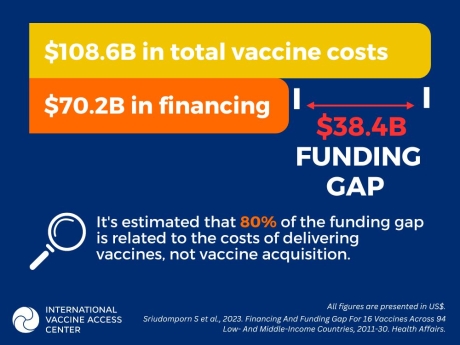IVAC Economics & Finance Team Highlights Immunization Financing Gap

The overall funding gap for the study period is estimated to be US$38.4B.
IVAC health economists, led by Bryan Patenaude, ScD, have recently published several papers focusing on the cost of procuring and delivering life-saving vaccines to increase coverage and meet Immunization Agenda 2030 (IA 2030) targets. Despite the sizable global investment in immunization programs over the past few decades, a considerable gap remains between the funding available and the funding needed to reach 2030 targets. The first paper, published in Health Affairs, analyzed the costs, financing, and funding gaps for 16 vaccines among 94 LMICs between 2011–2030. IVAC Research Associate Salin Sriudomporn, MHS, discussed findings from the paper as a guest on the Health Affairs podcast A Health Podyssey. The overall funding gap for the study period is estimated to be US$38.4B, Sriudomporn said, more than 80% of which is attributable to the cost of delivering the vaccine rather than the cost of the vaccine itself. The true funding gap is most likely much higher, since the study did not account for service disruptions and changes in donor funding related to the COVID-19 pandemic. To bridge this gap, the study authors recommend that countries take ownership of their national immunization programs to reduce dependency on donor financing, and suggest integrating vaccine programs with primary care services to reduce costs.
Sriudomporn also authored a second paper focusing on the resources required to achieve IA2030 goals for immunization coverage against 14 pathogens in 194 countries between 2021–2030. The total cost of procuring and delivering these vaccines is estimated to be US$269.8B. “The cost of achieving IA2030 targets is substantial and will increase over the next decade,” Sriudomporn said. “Resource mobilization and significant investments will be needed from both country governments and external funding sources for health system strengthening and to ensure equitable and sustainable vaccination programs.” She noted that this will be especially important in upper-middle income countries, which contribute to more than 40% of estimated vaccine costs.
This is just some of the innovative and exciting work being done by the IVAC Economics & Finance team, which recently published several additional papers. Together, these papers can be used to guide immunization-related decision-making, policy changes, advocacy, and future investments.
Other recent work by the team:
- Coverage and Equity of Childhood Vaccines in China
- COVID-19 impact on index testing services and programmatic cost in 5 high HIV prevalence Indian districts
- Economic impact of vaccine safety incident in Ukraine: The economic case for safety system investment
- Return on Investment of 10-Valent Pneumococcal Conjugate Vaccine in Ecuador From 2010 to 2030


